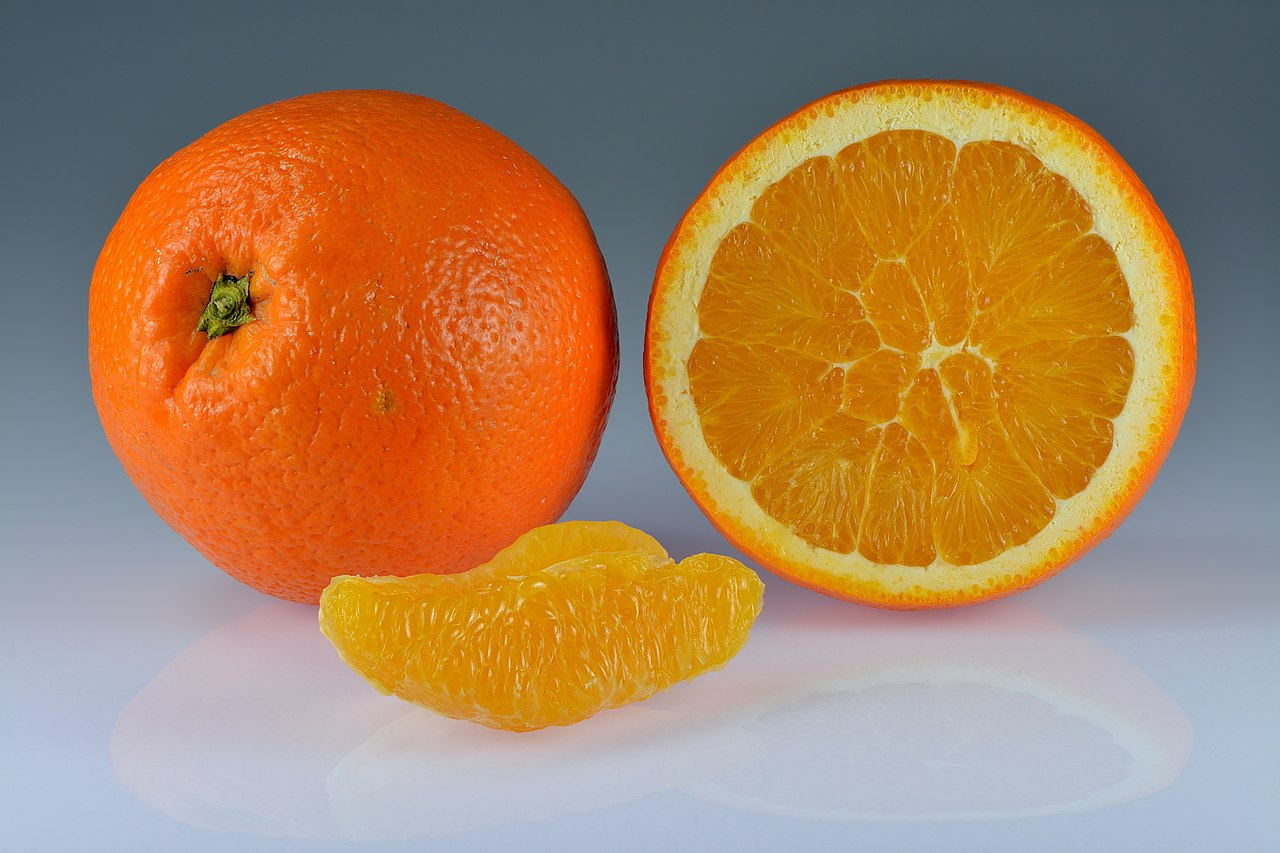An orange is a fruit of various citrus species in the family Rutaceae (see list of plants known as orange); it primarily refers to Citrus × sinensis,[1] which is also called sweet orange, to distinguish it from the related Citrus × aurantium, referred to as bitter orange. The sweet orange reproduces asexually (apomixis through nucellar embryony); varieties of the sweet orange arise through mutations.
The orange is a hybrid between pomelo (Citrus maxima) and mandarin (Citrus reticulata). The chloroplast genome, and therefore the maternal line, is that of pomelo. The sweet orange has had its full genome sequenced.
The orange originated in a region encompassing Southern China, Northeast India, and Myanmar, and the earliest mention of the sweet orange was in Chinese literature in 314 BC. As of 1987, orange trees were found to be the most cultivated fruit tree in the world. Orange trees are widely grown in tropical and subtropical climates for their sweet fruit. The fruit of the orange tree can be eaten fresh, or processed for its juice or fragrant peel. As of 2012, sweet oranges accounted for approximately 70% of citrus production.
In 2019, 79 million tonnes of oranges were grown worldwide, with Brazil producing 22% of the total, followed by China and India.
History
The sweet orange is not a wild fruit, having arisen in domestication from a cross between a non-pure mandarin orange and a hybrid pomelo that had a substantial mandarin component. Since its chloroplast DNA is that of pomelo, it was likely the hybrid pomelo, perhaps a BC1 pomelo backcross, that was the maternal parent of the first orange. Based on genomic analysis, the relative proportions of the ancestral species in the sweet orange are approximately 42% pomelo and 58% mandarin. All varieties of the sweet orange descend from this prototype cross, differing only by mutations selected for during agricultural propagation. Sweet oranges have a distinct origin from the bitter orange, which arose independently, perhaps in the wild, from a cross between pure mandarin and pomelo parents. The earliest mention of the sweet orange in Chinese literature dates from 314 BC.
In Europe, the Moors introduced the orange to the Iberian Peninsula, which was known as Al-Andalus, with large-scale cultivation starting in the 10th century, as evidenced by complex irrigation techniques specifically adapted to support orange orchards. Citrus fruits—among them the bitter orange—were introduced to Sicily in the 9th century during the period of the Emirate of Sicily, but the sweet orange was unknown until the late 15th century or the beginnings of the 16th century, when Italian and Portuguese merchants brought orange trees into the Mediterranean area. Shortly afterward, the sweet orange quickly was adopted as an edible fruit. It was considered a luxury food grown by wealthy people in private conservatories, called orangeries. By 1646, the sweet orange was well known throughout Europe. Louis XIV of France had a great love of orange trees and built the grandest of all royal Orangeries at the Palace of Versailles. At Versailles, potted orange trees in solid silver tubs were placed throughout the rooms of the palace, while the Orangerie allowed year-round cultivation of the fruit to supply the court. When Louis condemned his finance minister, Nicolas Fouquet, in 1664, part of the treasures that he confiscated were over 1,000 orange trees from Fouquet's estate at Vaux-le-Vicomte.
Spanish travelers introduced the sweet orange to the American continent. On his second voyage in 1493, Christopher Columbus may have planted the fruit on Hispaniola. Subsequent expeditions in the mid-1500s brought sweet oranges to South America and Mexico, and to Florida in 1565, when Pedro Menéndez de Avilés founded St Augustine. Spanish missionaries brought orange trees to Arizona between 1707 and 1710, while the Franciscans did the same in San Diego, California, in 1769. An orchard was planted at the San Gabriel Mission around 1804, and a commercial orchard was established in 1841 near present-day Los Angeles. In Louisiana, oranges were probably introduced by French explorers.
Archibald Menzies, the botanist and naturalist on the Vancouver Expedition, collected orange seeds in South Africa, raised the seedlings onboard, and gave them to several Hawaiian chiefs in 1792. Eventually, the sweet orange was grown in wide areas of the Hawaiian Islands, but its cultivation stopped after the arrival of the Mediterranean fruit fly in the early 1900s.
As oranges are rich in vitamin C and do not spoil easily, during the Age of Discovery, Portuguese, Spanish, and Dutch sailors planted citrus trees along trade routes to prevent scurvy.
Florida farmers obtained seeds from New Orleans around 1872, after which orange groves were established by grafting the sweet orange on to sour orange rootstocks.
Megathreads and spaces to hang out:
- ❤️ Come listen to music and Watch movies with your fellow Hexbears nerd, in Cy.tube
- 💖 Come talk in the New Weekly Queer thread
- 💛 Read and talk about a current topics in the News Megathread
- ⭐️ August Movie Nominations ⭐️
reminders:
- 💚 You nerds can join specific comms to see posts about all sorts of topics
- 💙 Hexbear’s algorithm prioritizes comments over upbears
- 💜 Sorting by new you nerd
- 🌈 If you ever want to make your own megathread, you can reserve a spot here nerd
- 🐶 Join the unofficial Hexbear-adjacent Mastodon instance toots.matapacos.dog
Links To Resources (Aid and Theory):
Aid:
Theory:
now all fediverse discussion will be considered a current struggle session discussion and all comment about it are subject to be removed and even banning from the comm.
have all of you a good day/night 

That whole crew was very queer friendly to my knowledge.
Still believe Arin is an egg